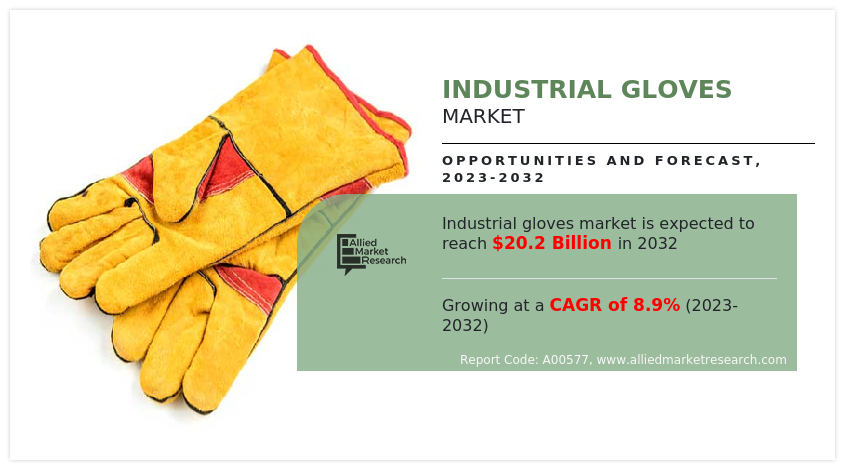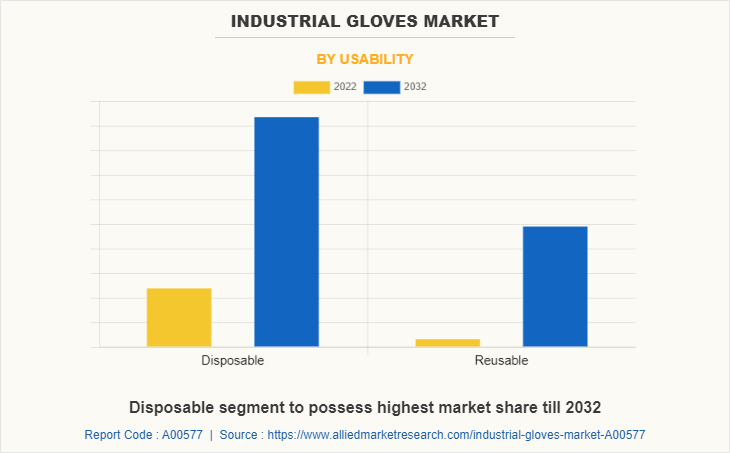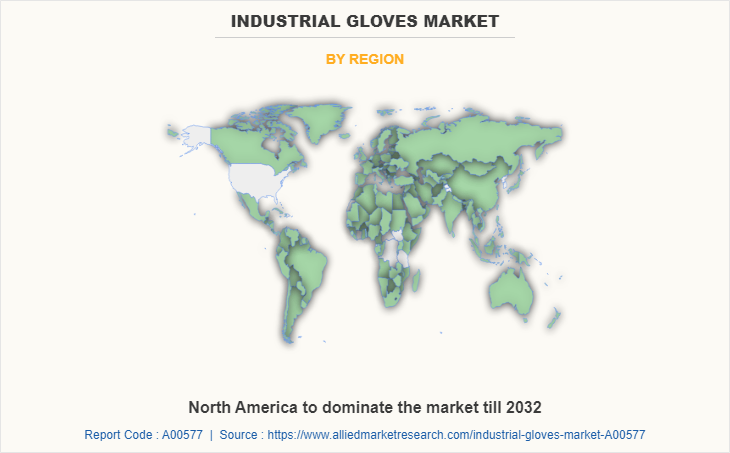Industrial Gloves Market Research, 2032
The global industrial gloves market size was valued at $8.7 billion in 2022, and industrial gloves industry is projected to reach $20.2 billion by 2032, growing at a CAGR of 8.9% from 2023 to 2032.
Report Key Highlighters:
- The global industrial gloves market covers sub-segments of both disposable and reusable gloves in detailed manner.
- The market has been analyzed in terms of value ($Million) and volume (Million Pairs). The anlysis in the report is provided on the basis of usability and four major regions covering more than 15 countries.
- The global industrial gloves market report includes detailed study covering underlying factors influencing the industry opportunities and trends.
- The report also provides detailed key participants analysis across the supply chain.
- The report also provides competitive landscape providing company profiles of major revenue contributers in the global industrial gloves market.

Industrial glovess are used as personal protective equipment in various industries such as automotive, food, and healthcare, to ensure workers’ safety and maintain sanitary conditions at workplaces. These glovess help to avoid cross-contamination and exposure to particulate matter during the manufacturing process across various industries. Industrial glovess can be disposable as well as reusable on the basis of the requirements of the specific work environment.
Reusable glovess are generally thicker and are used in harsher work environments, whereas disposable glovess are usually used in product protection and in milder work environments. Moreover, due to the harsh work environment, the threat of injury to the hands of the workers has increased significantly, thus creating an impending need for industrial glovess. Industrial glovess including reusable and disposable glovess have addressed this need as they offer hand protection and product protection, respectively.
The increase in awareness about work safety, rise in the variety of threats to the personnel, rapid developments in the food processing industry, and rise in demand for high dexterity glovess, are some of the key factors that are expected to drive the growth of the global industrial gloves market during the forecast period. In addition, the outbreak of epidemics such as swine flu, has been resulting in increased use of glovess in product protection applications significantly, which fosters the growth of the industrial gloves market.
However, factors restraining the market growth include the availability of local & inexpensive glovess and lack of awareness regarding the usage of industrial glovess. The implementation of innovative technologies is expected to offer better growth prospects for the growth of the industrial gloves market in the future.
"A Look at the Industrial Industrial glovess Market in Developing Countries"
The industrial industrial glovess market is an essential sector, especially for workers in developing countries. As the manufacturing industry continues to witness growth, the need for industrial glovess is increasing. However, in many developing countries, the use of industrial glovess is often overlooked or not given much priority.
The demand for industrial glovess in developing countries has been driven by a growing awareness of the need for occupational health and safety. This awareness has been fueled by international organizations, such as the International Labor Organization, World Health Organization and others, which have been advocating for better working conditions for workers in developing countries. In addition, many companies that operate in developing countries are now required to comply with international safety standards, which has further increased the demand for industrial gloves.
One significant challenge facing the industrial industrial gloves market in developing countries is the availability of affordable, high-quality gloves. Local manufacturers in these countries have been producing a significant number of gloves, but a concern is that the quality of these gloves is subpar and may not meet global safety standards. One contributing factor to this issue is the insufficient investment in research and development by these manufacturers. The result is that many workers are using gloves that offer limited protection or may even be harmful to their health.
Another challenge is the lack of awareness and education about the importance of industrial gloves. In many developing countries, workers may not be aware of the risks they face or the need for industrial gloves. In addition, employers may not prioritize the use of industrial gloves due to a lack of knowledge or budget constraints.
Despite these challenges, the industrial industrial gloves market in developing countries is showing significant potential for growth. Local manufacturers are beginning to invest in research and development, and international companies are partnering with local businesses to improve the quality of gloves produced. In addition, there is a growing trend towards sustainable and environment-friendly gloves, which presents an opportunity for manufacturers to differentiate themselves in the market.
"How Changes in Healthcare Regulations are Affecting the Industrial gloves Market"
Healthcare regulations are having a significant impact on the industrial gloves market. Governments around the world are increasing regulations and guidelines for personal protective equipment (PPE) used in healthcare settings to ensure the safety of healthcare workers and patients. These regulations are changing the way industrial gloves are made, tested, and used, which is affecting the industrial gloves market.
One of the main ways healthcare regulations are affecting the industrial gloves market is by increasing the standards for PPE. Governments are mandating that healthcare workers use gloves that meet certain performance standards to protect against chemical exposure, infectious diseases, and other hazards. These regulations are driving innovation in the market, as manufacturers develop new materials and technologies to meet these higher standards. For example, gloves are now being made with antimicrobial coatings to reduce the risk of contamination and using materials that provide better grip and sensitivity.
Another way healthcare regulations are affecting the industrial gloves market is by increasing the use of gloves in healthcare settings. Regulations are mandating that healthcare workers use gloves more frequently and for longer periods, which is driving the demand for gloves. Healthcare regulations are also mandating that healthcare workers change gloves more frequently, which is increasing the volume of gloves used in healthcare settings.
The increased regulations are also impacting the way industrial gloves are tested and certified for use in healthcare settings. Governments are requiring more stringent testing and certification processes for industrial gloves, which is increasing the time and cost required to bring new gloves to the market. Manufacturers need to ensure that their gloves meet these new standards to be able to sell their products in the healthcare market.
Finally, healthcare regulations are driving changes in the supply chain for industrial gloves. Governments are mandating that healthcare providers source their gloves from reputable suppliers and that they have adequate supplies to meet their needs. This is driving the demand for gloves from established suppliers and creating new opportunities for manufacturers to enter the market.
The global industrial gloves market forecast is segmented into usability and region. On the basis of usability, the market is categorized into disposable and reusable. On the basis of material type for disposable, the market is categorized into natural rubber, nitrile, vinyl, neoprene, polyethylene, and others. On the basis of end-use for disposable, the market is classified into aerospace, disk drives, flat panels, food, hospitals, medical devices, pharmaceuticals, semiconductors, and others. On the basis of gloves type for reusable, the market is categorized into dipped gloves, knitted gloves, supported knitted gloves, and others. On the basis of protection for reusable, the market is categorized into general purpose/mechanical protection, chemical/liquid protection, and product protection. On the basis of end-use for reusable, the market is divided into machinery, oil & gas, metal fabrication, automotive, chemical, construction, plane manufacturing, food processing, office building cleaners, healthcare, and others. Region wise, it is analyzed across North America, Europe, Asia-Pacific, and LAMEA.

By usability, it is divided into disposable and reusable gloves. The disposable gloves segment accounted for the largest revenue share in the global industrial gloves market in 2022. This growth in demand can be attributed to the presence of demand for disposable gloves in various end-use industries or sectors such as the medical, pharmacy, and others.
By material type for disposable gloves, it is divided into natural rubber, nitrile, vinyl, neoprene, polyethylene, and others. The natural rubber segment accounted for the largest revenue share in the global industrial gloves market in 2022. This growth in demand can be attributed to the presence of demand for natural rubber gloves in industries such as food processing and pharmaceuticals to maintain high levels of hygiene and prevent contamination.
By end use for disposable gloves, it is divided into aerospace, disk drives, flat panels, food, hospitals, medical devices, pharmaceuticals, semiconductors, and others. The semiconductor segment accounted for the largest revenue share in the global industrial gloves market in 2022. This growth in demand can be attributed to the increase in demand for consumer electronics across the globe. The demand for semiconductors and electronics assembly has surged considerably. This factor is expected to increase the demand for nitrile gloves in the semiconductor industry in the near future.
By gloves type for reusable gloves, it is divided into dipped gloves, knitted gloves, supported knitted gloves, and others. The supported knitted gloves segment accounted for the largest revenue share in the global industrial gloves market in 2022. Rise in demand for cut-resistant gloves across a range of industries has been encouraging manufacturers to develop gloves with advanced materials that provide superior cut resistance. In addition, there is a strong emphasis on comfort, with manufacturers using advanced knitting techniques and materials to improve breathability and reduce hand fatigue. This is expected to provide ample opportunities for the development of the market.
By protection type for reusable gloves it is divided into general purpose/mechanical, chemical/liquid, and product protection. The general purpose/mechanical segment accounted for the largest revenue share in the global industrial gloves market in 2022. The demand for gloves with advanced ergonomic designs, reinforced stitching, double-layered materials, and embedded sensors that can monitor vital signs or detect exposure to harmful substances is expected to provide ample opportunities for the development of the market.
By end use for reusable gloves, it is divided into machinery, oil & gas, metal fabrication, automotive, chemical, construction, plane manufacturing, food processing, office building cleaners, healthcare, and others. The oil & gas segment accounted for the largest revenue share in the global industrial gloves market in 2022. In the oil & gas industry, crushing, pinching, cutting, and puncturing hazards make up most of the serious hand injuries to workers that have led to an increase in the demand for protection gloves across the oil & gas industry.

Region-wise, North America accounted for the largest market share in the market. As the most developed region across the globe, this region has major manufacturers related to all industries such as consumer electronics, aerospace & defense, automotive, and others.
The introduction of advanced products such as puncture-proof gloves, temperature-resistant gloves, and others, has fueled the growth of this market. Owing to all these factors, the North America region has the most advanced type of industrial gloves in the market.
IMPACT OF COVID-19 ON THE GLOBAL INDUSTRIAL GLOVES MARKET
The COVID-19 pandemic had an unprecedented impact on the global market for industrial gloves. The need for personal protective equipment (PPE) to prevent the spread of the virus has led to a massive surge in demand for gloves, primarily in the healthcare sector. The demand for gloves has also increased among the general public as people seek to protect themselves from the virus. This surge in demand had led to shortages in many parts of the world, creating significant challenges for healthcare systems and other essential industries. The shortages have been exacerbated by disruptions in the supply chain due to lockdowns, travel restrictions, and other measures implemented to contain the spread of the virus.
The pandemic led to significant price increases for gloves, with some suppliers charging several times more than the pre-pandemic prices. This put a strain on healthcare systems, as well as on individuals and businesses that needed to purchase gloves for their employees. The price increases have been driven by the shortage of supply, with many manufacturers struggling to keep up with the demand.
The surge in demand for gloves has spurred innovation in the market, with manufacturers developing new materials and technologies to improve the effectiveness of gloves and increase their durability. For example, some manufacturers have developed gloves with antimicrobial coatings to reduce the risk of contamination, while others have developed gloves with improved grip to make them more effective for use in wet conditions.
The increased innovation in the market is expected to continue in the coming years, as demand for gloves is projected to remain high even after the pandemic subsides. Despite the significant demand for gloves, the increased use of industrial gloves has raised concerns about their environmental impact. Many gloves are made from non-biodegradable materials, and the increase in demand has led to a significant increase in the amount of waste generated. Manufacturers are increasingly being encouraged to create gloves that are more environmentally sustainable by using biodegradable materials or recycling existing materials, to minimize the negative impact on the environment. In conclusion, the COVID-19 pandemic has significantly impacted the global industrial gloves market.
Competitive Landscape
Some of the major players analyzed in this report are Top Gloves Corporation Berhad, Hartalega Holdings, Kossan Rubber Industries Bhd, Riverstone Holdings Limited, Careplus Group Berhad, Supermax Corp., Ansell Healthcare, SHOWA, Inc., Honeywell International Inc., and Semperit AG Holding.
Key Benefits For Stakeholders
- This report provides a quantitative analysis of the market segments, current trends, estimations, and dynamics of the industrial gloves market analysis from 2022 to 2032 to identify the prevailing industrial gloves market opportunities.
- The market research is offered along with information related to key drivers, restraints, and opportunities.
- Porter's five forces analysis highlights the potency of buyers and suppliers to enable stakeholders make profit-oriented business decisions and strengthen their supplier-buyer network.
- In-depth analysis of the industrial gloves market segmentation assists to determine the prevailing market opportunities.
- Major countries in each region are mapped according to their revenue contribution to the global market.
- Market player positioning facilitates benchmarking and provides a clear understanding of the present position of the market players.
- The report includes the analysis of the regional as well as global industrial gloves market trends, key players, market segments, application areas, and market growth strategies.
Industrial Gloves Market Report Highlights
| Aspects | Details |
| Market Size By 2032 | USD 20.2 billion |
| Growth Rate | CAGR of 8.9% |
| Forecast period | 2022 - 2032 |
| Report Pages | 691 |
| By Usability |
|
| By Region |
|
| Key Market Players | Top Glove Corporation BHD, Honeywell International Inc., Ansell Limited, Hartalega Holdings BHD, Semperit AG Holding, Kossan Rubber Industries BHD, Riverstone Holdings Limited, Supermax Corporation Berhad, Careplus Group Berhad, Globus Group |
Analyst Review
According to the CXOs of leading companies in the market, the global industrial gloves market has witnessed a significant increase in demand in recent years. This can be attributed to the growing awareness about the importance of safety measures in the workplace and the rise in the number of workplace injuries. Industrial gloves have become a critical component in ensuring worker safety across various industries such as machinery, oil & gas, metal fabrication, automotive, chemical, construction, plane manufacturing, food processing, office building cleaners, and healthcare.
The CXOs highlight that the use of industrial gloves in the U.S. has seen a significant increase in recent years, particularly in the healthcare and food processing industries. The consumption of industrial gloves is highest in the U.S. due to the strict regulatory requirements in these industries. The U.S. Food and Drug Administration (FDA) mandates the use of industrial gloves in the food processing industry to prevent contamination and ensure hygiene standards are met. Similarly, the Occupational Safety and Health Administration (OSHA) requires employers to provide industrial gloves to workers who are exposed to workplace hazards, including chemical and biological agents.
Moreover, the use of industrial gloves has also increased in the manufacturing industry where gloves protect workers from heat and other temperature concerns, chemicals, and cuts & bruises. The surge in the application of industrial gloves in the chemical, pharmaceutical, and oil & gas industries is also driving the growth of the industrial gloves market. With the increasing awareness of workplace safety, companies are expected to invest more in protective equipment, including gloves, to ensure the safety of their workers.
According to the CXOs, Asia-Pacific is projected to register significant growth as compared to the saturated markets of North America and Europe. The growth of the industrial gloves market in Asia-Pacific can be attributed to the increasing demand for industrial gloves in developing countries such as China and India. These countries have witnessed a significant increase in manufacturing activities, leading to an increased demand for industrial gloves. Furthermore, the rise in awareness of workplace safety and the implementation of stringent regulations by the government are driving the growth of the industrial gloves market in the region.
Increasing awareness regarding personal safety and hygiene and growth in end-use industries are the key factors boosting the Industrial gloves market growth.
The market value of Industrial gloves in 2032 is expected to be $20.2 billion
Top Gloves Corporation Berhad, Hartalega Holdings, Kossan Rubber Industries Bhd, Riverstone Holdings Limited, Careplus Group Berhad, Supermax Corp., Ansell Healthcare, SHOWA, Inc., Honeywell International Inc., and Semperit AG Holding
Oil and gas industry is projected to increase the demand for Industrial gloves Market
The global industrial gloves market forecast is segmented into usability and region. On the basis of usability, the market is categorized into disposable and reusable. Region wise, it is analyzed across North America, Europe, Asia-Pacific, and LAMEA.
Expansion in emerging markets is the Main Driver of Industrial gloves Market.
Loading Table Of Content...
Loading Research Methodology...



